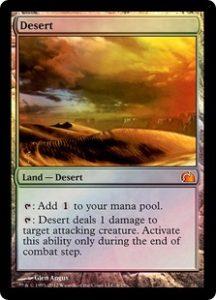“Even as the Eldrazi plagued the land, someone had uprooted the land’s soul and trapped it here to die. Who could be so cruel?” – Kimberly Kreines, “Nissa’s Resolve,” Uncharted Realms.
In this week’s Uncharted Realms, Nissa confronts Ob Nixilis at the Khalni Heart, source of Zendikar’s life amidst the devastation of Bala Ged. Long imprisoned beneath the earth of the plane, the demon Ob Nixilis is determined to take revenge on his former prison, and digs up the fertile core of the world’s life in order to desecrate and ultimately destroy it. After a fierce battle, Nissa prevails over the vengeful planeswalker, and regains her connection to the plane and her elemental protector, Ashaya.
To Kill A World
What does it take to destroy a place?
For Ob Nixilis, the answer is simple, if arcane. Zendikar has a beating heart in the fragile Khalni sapling sought by Nissa. By tearing it from the earth, Ob Nixilis wrenches Nissa free of her connection to Zendikar, and ultimately dooms the plane to a slow death, like a plant torn free from the nurturing soil. Only Nissa’s intervention saves her world from destruction.
Earth, like Zendikar, is a resilient world. But it doesn’t take a lot for a place to become uninhabitable for humans, as adaptive and resourceful as we are. While nowhere on Earth is completely hostile to our hardy species, there are spaces on the map where life once thrived that now reflect nearly no trace of human civilization. It does not take Ob Nixilis’ vengeance to destroy a place entirely.
For the longest time, no force could match the potential of subtle environmental shift in its capacity for total destruction. The conditions for life and human settlement were delicate, and a change in the wind, temperature, rainfall, or countless other variables could spell doom for the ecosystem of a village or city – or even a world.
The Sahara Desert, it is understood, was once an ecologically diverse and verdant savannah, like much of the grasslands beneath it. At one point, the tilt of the Earth as compared to the sun (which is now measured at 23.45 degrees) was different by a margin of .59 degrees (24.14), such that the equatorial belt was slightly shifted.1 The Sahara, as a result, received abundant rainfall, and housed a lake the size of the United Kingdom – as well as human civilization. Cave paintings in the modern desert reveal a portrait of a diverse grassland, with antelope, giraffes, and people now absent from the landscape. A shift of mere fractions of a degree over the course of countless years slowly starved the Sahara of rain, and the desert we know today emerged from a place of abundant animal and human life.
But on an infinitely greater scale, a subtle shift in the environment can destroy entire worlds. Data arriving only now from Mars reveals the extent of water in frozen polar caps, rivers, and seas across the world, occasionally even thawing to flow across the surface of the red planet.2 The presence of such abundant water suggests the possibility of life that once existed on the world. Despite this promise, however, Mars lies arid and desolate. It is likely that the lack of magnetic poles to generate a universally strong magnetic field doomed the planet, leaving the atmosphere to dissapate rather than form and shelter flowing water and emerging life. The merest subtle shift in climate and environment could doom an massive ecosystem or an entire world.
“Carthago Delenda Est”
If humanity has a knack for survival, so too do we possess a gift for destruction. Throughout history, tyrants like Ob Nixilis have decided, for a variety of reasons, that a place ought no longer to exist. This column has looked at monumental acts of violence before, like the Crusaders’ massacre at Jerusalem in 1099 CE, but occasionally human warfare destroys more than human lives and indelibly marks the landscape.
In some of these cases, the decision was deliberate. The phrase “Carthago delenda est” – “Carthage must be destroyed” – lives on in history as a famous and abbreviated phrase3 from the Roman senator Cato. After more than a century of sustained warfare against the Carthaginian state, Roman political leadership sought to end any lasting threat presented by this longtime rival by utterly annihilating the capital for which it was named. After conquering the city in 146 CE, on orders from the Senate the Roman general Scipio Aemilianus enslaved or displaced its inhabitants, razed the city, and plowed salt into the earth such that no crops would grow to sustain new habitation. Although the site continued to be sparsely populated and is today a suburb of the Tunisian capital, Carthage would never regain its prominence as a city and civilization after its utter destruction.
“Scipio, when he looked upon the city as it was utterly perishing and in the last throes of its complete destruction, is said to have shed tears and wept openly for his enemies… realizing that all cities, nations, and authorities must, like men, meet their doom.” – Polybius, The Fall of Carthage.
Other conquering armies sought similar destruction out of spite or simple accident. The Mongol Empire, which it must be said is largely condemned by outsiders (like myself) who got to write the history books, is occasionally cited as the cause of a massive ecological disaster which destroyed thousands of years of irrigation on the Iranian plateau. The ancient home of Persian civilization was largely desert and depended upon complex systems of irrigation trenches called qunat to provide for its urban population, concerns that were largely alien or unimportant to the Mongol conquerors operating from a nomadic culture in an equally harsh climate. When they rode through the Kwarismian Empire in the early 13th century, the Mongol armies destroyed the qunat or slew the farmers who maintained it. In their wake, the desert claimed the once-fertile farmland and made whole swathes of Persian territory uninhabitable.
No matter how much ancient civilizations could destroy the cities and territory of their rivals, or the extent to which subtle environmental shifts can doom an entire landscape and world, they both may find their match in the potential of modern humanity. The landscape of Chernobyl bears eerie testimony to our species’ capacity for destruction. Abandoned by humanity in the wake of a catastrophic nuclear plant meltdown, the former city is now a peerless wildlife refuge, where no human can trespass safely thanks to the risk of radiation. Ultimately, however, the evidence of human-influenced climate change is a far more sobering trend – for the first time, we can not only make the planet uninhabitable for our enemies, but for vast swathes of the ecosystem as we know it. We, like the demon Ob Nixilis, hold an incredibly delicate treasure, and with it the possibility of a world’s life and death.
1 http://www.sciencedaily.com/releases/1999/07/990712080500.htm
2 http://mars.nasa.gov/news/whatsnew/index.cfm?FuseAction=ShowNews&NewsID=1858
3 Frankly, I thought it meant “Carthage is destroyed,” but apparently I am wrong.





